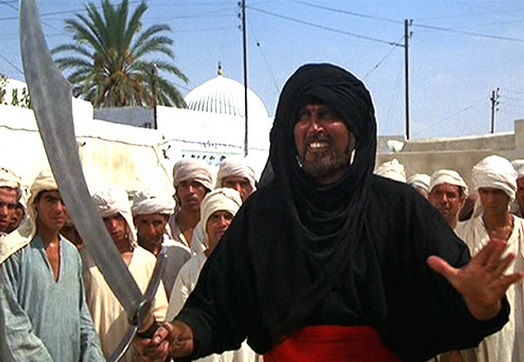  |
 |
 |
 |
|
MahdiWatch.org
|
 |
|
Home | About Me | Links to My Articles | Info on My Books | Contact Me
|
 |
|
Welcome to MahdiWatch.org! NEWSFLASH! COMMENTS LINK
BELOW EACH POST IS ENABLED! FEEL FREE TO BURY ME, PRAISE ME--OR JUST ISSUE A PERSONAL FATWA!
al-Mahdi is "the rightly-guided one" who, according to Islamic Hadiths (traditions),
will come before the end of time to make the entire world Muslim. Over the last 1400 years numerous claimants to the
mantle of the Mahdi have arisen in both Shi`i and Sunni circles. Modern belief in the coming of the Mahdi has
manifested most famously in the 1979 al-`Utaybi uprising of Sa`udi Arabia, and more recently in the ongoing
Mahdist movements (some violent) in Iraq, as well as in the frequently-expressed public prayers of former Iranian
President Ahmadinezhad bidding the Mahdi to return and, in the larger Sunni Islamic world, by claims that Usamah bin Ladin
might be the (occulted) Mahdi. Now in 2014 Mahdism is active in Syria, as the jihadist opposition group Jabhat al-Nusra
claims to be fighting to prepare the way for his coming; and in the new "Islamic State/caliphate" spanning
Syrian and Iraqi territory, as its leadership promotes the upcoming apocalyptic battle with the West at Dabiq, Syria. This site will track such Mahdi-related movements, aspirations, propaganda and beliefs in both Sunni and Shi`i
milieus, as well as other Muslim eschatological yearnings.
For a primer
on Mahdism, see my 2005 article, "What's Worse than Violent Jihadists?," at the History News Network: http://hnn.us/articles/13146.html; for more in-depth info, see the links here to my other writings, including my book on Mahdism.
|
|
|
|
Tuesday, June 17, 2014
The Hour of ISIS Power: How Did It Come To This?
The Hour of ISIS Power
The Islamic State of Iraq and al-Sham [Greater
Syria], also known (less accurately) as the Islamic State of Iraq and the Levant, is for all its brutality—beheadings, destroying churches, mass executions—no longer merely a terrorist organization; it has now formed a renegade military
theocracy and is in the process of creating a new Sunni territorial state in the Middle East. ISIS’s
current area of control is roughly along these lines: 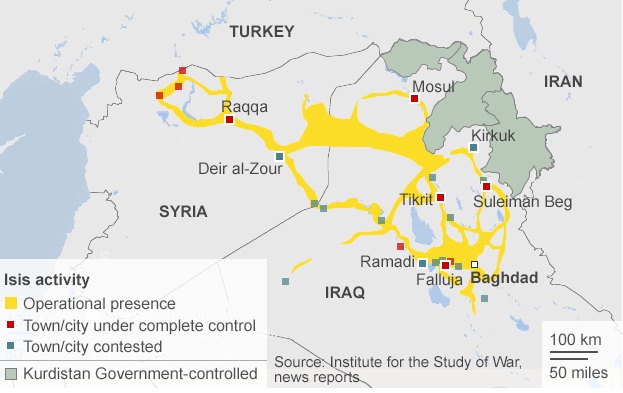
How did it come
to this? Geographically, the Middle East is not just reverting to its more natural pre-World War I Ottoman-era
delimitations, but is falling back into something more resembling the geographical layout imposed by the Abbasids in the 8th-13th
centuries AD:
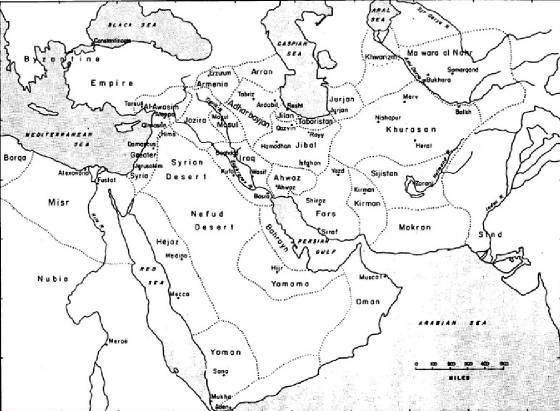
Baghdad was the imperial center for the Abbasids, and not merely a provincial
capital as it was under the Ottomans. Indeed, it may well be that ISIS aims to take Baghdad in order to
cement its self-styled ambition to recreate the caliphate—since the Arab Abbasid Caliphate (not the Turkish Ottoman one) is considered by many Arabs to be the “Golden Age”
of Islamic civilization. By the
16th century, when the Ottomans had long since displaced the Abbasids, the area of “Mesopotamia” became a contested
and bloody buffer zone between that Sunni Turkish empire and the new Twelver Shi`i Persian one in Iran, the Safavids.
(And note: ISIS refers to Iraqi, not just Iranian, Shi`is as “Safavids.”) Iranian rule, whether under the
Safavids or their successors, periodically reinforced and grew the Twelver Shi`i population of “Iraq”—the
region on the following map from Mosul to the Persian Gulf: 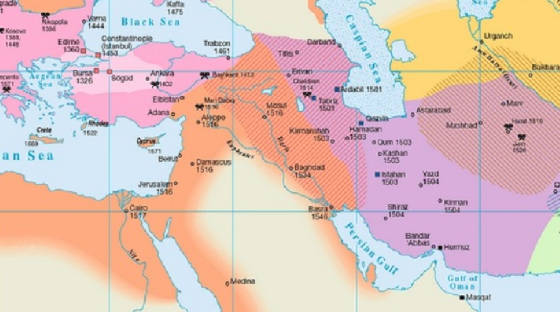
Eventually the Ottomans consolidated their control over the region,
and by 1900 what is now Syria and Iraq would have consisted of the Ottoman provinces (whether vilayets, sancaks or other administrative
divisions) of Damascus, Halab (Aleppo), Dayr al-Zur, Mosul, Baghdad and Basra. 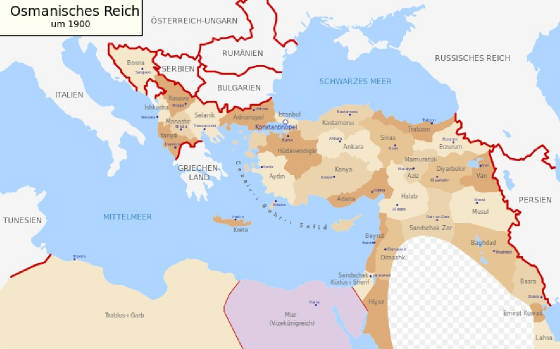
By the eve of World War I, the relevant vilayets included Dayr
al-Zur, Mosul, Baghdad and Basra: 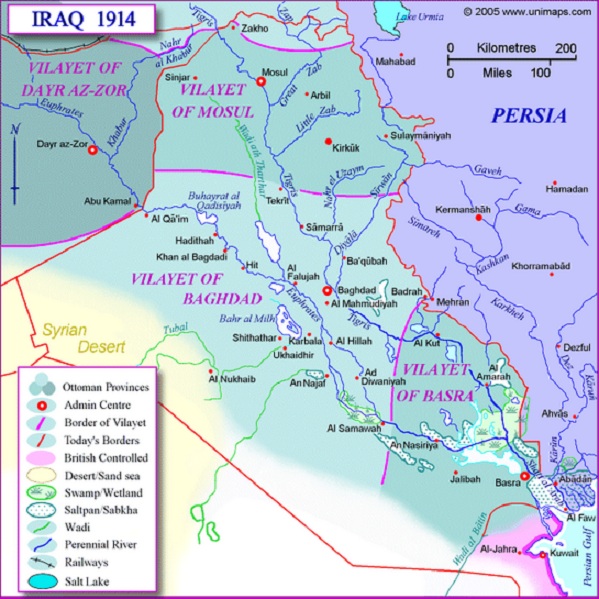
With the Ottoman defeat, and eventual imperial dissolution, after
1918, the French and British obtained from the League of Nations the following mandates: 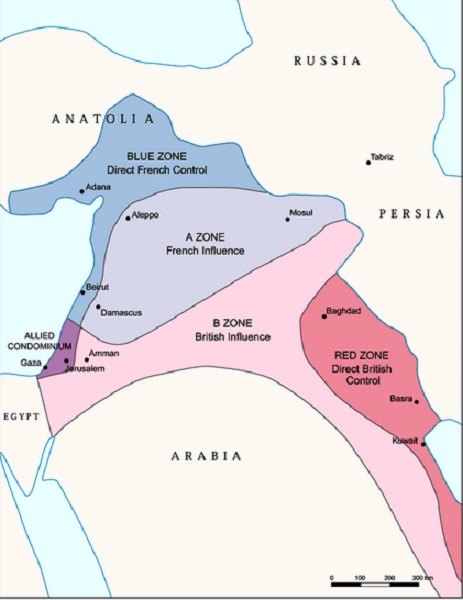
These, of course, eventually were modified by events, most notably
the nascent Turkish Republic’s refusal to cede any of Anatolia—resulting in the creation of the Arab states of
Lebanon, Syria, [Trans]Jordan, Iraq and, of course, the Jewish nation of Israel. ISIS is forcibly and brutally dragging the Arab Middle East back
to the future, by erasing the borders between two of the four Arab states hacked from the Ottoman Empire’s dying carcass
and making the entire old Ottoman vilayet of Dayr al-Zur, as well as large chunks of Mosul and Baghdad vilayets, the core
of the new caliphate: 
(Thanks to 40 maps that explain the Middle East.)
So what are the major points about ISIS which
conventional wisdom gets wrong?
1) ISIS is not
al-Qa`ida [AQ]. Like the vast majority of Islamic terrorist groups, or VEOs (“violent extremist organizations”), ISIS operates independently of AQ
and is motivated by a literal reading of the Qur’an and a desire to recapitulate the historical example—in terms
of both conquest and imposition of Islamic norms via shari`a—of Islam’s founder, Muhammad.
In fact, ISIS may now have eclipsed AQ in terms of monetary reserves and global Islamic (fundamentalist) cachet; it’s certainly more powerful than AQ
in that it rules a state in the center of the Middle East and is not relegated to the geopolitical margins (Yemen, the western
Sahara desert, Pashtunistan).
2) In addition, ISIS is, if anything, even more religious than AQ. Its leader,
Ibrahim Awwad Ibrahim al-Badri, holds a PhD in fiqh, or Islamic jurisprudence (fatwa-issuing, in other words).
By contrast, Usama bin Ladin was an engineer and Ayman al-Zawahiri is a medical doctor; and although both were/are
profoundly Islamic in worldview and goals, they were/are laymen. al-Badri fits into the emerging paradigm of jihadist
leaders who have advanced training in Islamic theology, such as Abubakr Shekau of Nigeria’s Boko Haram [BH], and Mamman
Nur of the BH offshoot Ansaru. Such men are even more willing than UBL or al-Zawahiri to adduce Islam as
motivation and justification for their actions—and can defend their literalist articulation of the Qur’an and
Hadiths (Islamic traditions) much more legitimately than the previous generation of non-scholar jihadist leaders. Part-and-parcel
of this Islamic rhetoric is that al-Badri adopted the nom de jihad “Abu Bakr al-Baghdadi.”
Abu Bakr was the first caliph of Islam after Muhammad’s death, and such a name resonates with those who wish
to bring back caliphal rule. Also, this Salafi hearkening back to the first generation of Islam—the
Salaf were the “pious ancestors,” akin to the Apostolic Age for Christians, albeit holding power
and violent—is what both drives and legitimizes imposition of Islamic law and the relegation of Christians in ISIS-controlled
territory to oppressed dhimmi status. Such a brutally verbatim reading of Islamic texts and
adherence to Muhammadan practices is also what drives ISIS’s decapitations and crucifixions of opponents (whether Shi`i or Christian). According to ISIS, the Iraqi government is staffed with Safavids; that of Syria is a den of Nusayris (the
old term for the pseudo-Shi`i Alawis); and the USA is a nation of Crusaders who defend the Cross. Open
religious war is upon us, whether we would admit it or not.
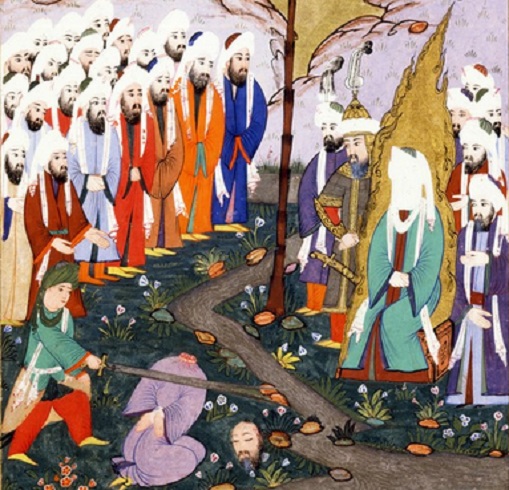
Muhammad giving his assent to Ali's beheading of al-Nadr b. al-Harith, mocker of Islam's prophet.
3) ISIS’s success amounts to Pan-Islam
tossing Pan-Arabism into an ummarked grave, but ISIS did not kill Pan-Arabism; neither, for that matter, did the “Arab Spring.” The political ideology based on shared Arab language and culture
and, usually, socialism—exemplified by the failed Egypt-Syria merger into the United Arab Republic and the Ba`ath party of Saddam Hussein and the al-Asad family—was always more elite-driven than popular, and
by the mid-1960s was taking taking body blows from much older and legitimately indigenous Islamic views of politics.
One might well see 1979 as the year in which Pan-Arabism finally succumbed to Islam, courtesy of the Iranian Revolution
(yes, even Sunni Arab Muslims were influenced by a Twelver Shi`i Persian event), the abortive Mahdist coup in Sa`udi Arabia
and the rise of the mujahidin to fight the Soviet invasion of Afghanistan. ISIS’s territorial
gains in Syria and Iraq, and the reports of Iraqi government troops throwing down their arms and running, demonstrate that Sunni Pan-Islam is firmly in control of events on the ground
there.
4) The Kurds
are one of the few Middle Eastern groups, and the most obvious, that stand to gain from ISIS’s advances—albeit
at the expense of extant nation-states, notably Syria and Iraq. They were the main ethnolinguistic
group which was short-changed at the end of World War I, and now these 30+ million stateless people might finally benefit
from the erasure of the colonial borders. Take a look at this map, showing areas of ISIS’s
“caliphate” and those of Kurdish dominance: 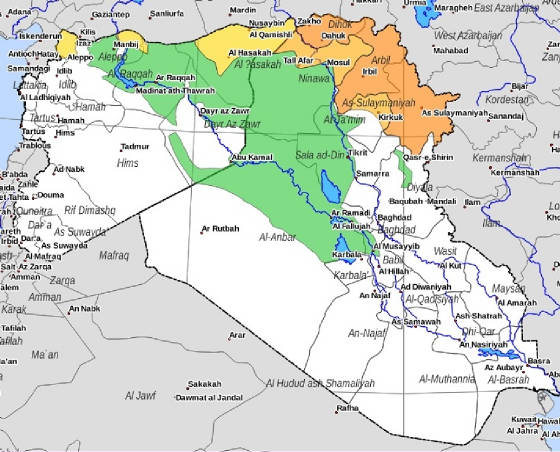
(Thanks to urbanpolicy.net.)
Syria’s jazira, that “peninsula” in the
country’s northeast, is a de facto Kurdish state, contiguous to the extant autonomous Kurdish one in northern Iraq.
The Turks almost certainly don’t like it, but Ankara should also realize that ISIS rocks the casbah far worse than the Kurds do, or would. Also, hopefully, President
Erdoğan—who seems to style
himself something of a neo-Ottoman ruler—will remember that the Ottoman sultans often had to put down Islamic fundamentalist
(sometimes Mahdist) jihads, in places like Arabia, Yemen and Sudan. As for Iraq: at this point, the central
government in Baghdad will be fortunate if it manages to hang onto a rump state in the vilayets of Baghdad and Basra, for
the provinces of al-Anbar and Ninawah (Nineveh) appear irretrievably lost. Likewise,
Bashar al-Assad should count on, at best, preserving a rump Syrian state, heavily Alawi and Christian, along the western coastal
strip and including Damascus—while most of the rest of Sunni Syria defects to the caliphate. This
would perhaps reduce Alawi-Sunni acrimony, if the latter are not ruled by an “apostate” group. It
would also help the plight of Christians, who get along far better with Alawis than with militant Sunnis.
5) As if ISIS is not bad enough with its jihadism, there are disturbing hints of eschatological thinking
and Mahdism among that group and its allies. In a 2011 communique, al-Qa`ida in Iraq—the ISIS predecessor organization—referred
to the Shi`i militia Jaysh al-Mahdi (“Army of the Mahdi”) as the “army of the Dajjal.” Al-Dajjal
or more fully al-Masih al-Dajjal is “the Deceiving Messiah,” who comes before the end of time to
combat the (Islamic) forces of the returned Muslim prophet Jesus and his ally, the Mahdi. Perhaps AQI was
merely invoking the Dajjal to mock Muqtada al-Sadr’s group; if not, then AQI/ISIS would seem to have
an eschatological bent. This latter explanation is reinforced by the eschatological explanations offered just six months ago by the official spokesman for the Chechen contingent of ISIS in
Syria: “Issa [Jesus]…will come down here, and al-Dajjal will come out here, it is the land of epics and the land
of resurrection.” ISIS’s rival Jabhat al-Nusra was even more overtly eschatological, openly invoking the primary End Times figure of Islam: the Mahdi. For most, if not all, the Sunni groups fighting jihad in Syria and, now
(again), Iraq, eschatology is a key motivator—in terms of enemies (“Safavids,” “army of the Dajjal”), motivation
(preparing the way for the Mahdi’s coming) and goals (regional, then global caliphate as well as eventual conquest of
al-Quds, Jersualem); ISIS is likely no exception to this world-view.
Some thought Usama bin Ladin was the Mahdi (and, after he assumed room temperature, that he had become the Hidden Imam). No one has yet proclaimed Abu Bakr al-Baghdadi the Mahdi—but
if Islamic history is any guide, it’s just a matter of time. Once the caliphate is firmly established, then the likelihood of a Mahdiyah being proclaimed increases. And
as I noted in my book Holiest Wars, “Muslim messianic movements are to fundamentalist uprisings what nuclear weapons are to conventional ones:
triggered by the same detonating agents, but far more powerful in scope and effect.”
What can we, the Iraqi government, or other states in the
region do against such reckless hate? Air or drone strikes might take out ISIS convoys rolling down the
highway toward Baghdad. But ISIS fighters tend to blend in and disappear into the local population—in
fact, they seem to have much popular Sunni support against the Maliki government—so would not be good targets for aerial
termination. Assuming that the Iraqi army lacks the will to stop ISIS, foreign ground troops are needed.
The Saudis are not going to prop up a Shi`i state, and have no combat experience. The Turks are a much
more impressive military, but still suffer from the Ottoman imperial legacy, and Ankara has little desire to foster Kurdish
irredentism by helping take out their major rival. Iran has made noises about sending in forces, but the
ayatollahs are wary of provoking even more opposition from the surrounding Sunni countries (both Arab and Turkey).
And despite reports of proposed US-Iran cooperation against ISIS, just how such an alliance of convenience would stave off the
ISIS advance has yet to be spelled out. That leaves either US conventional or special forces.
President Obama has categorically ruled out the former, but is said to be considering the latter—although how doing so while barring them from combat and limiting them to “non-operational
training” would be of any benefit remains a mystery.
But in any event, it is hard to see how ISIS can be defeated purely militarily. It might
be stopped from the Baghdad vilayet, but ISIS will continue to rule large sections of Iraq and Syria. Its
Islamic ideology, brutal though it may be, appeals to many Sunnis in both countries. It
will take two elements to defeat ISIS: 1) A united “moderate” Sunni front, religious and ideological, which can
delegitimize ISIS—but Iraq and Syria both lack Sunni clerics of sufficient stature to do so. Yusuf al-Qaradawi or the institution of al-Azhar in Cairo might do the trick, but neither seems willing to get involved. 2) Boots of seasoned
warriors on the ground—which means Americans. That’s not happening under this administration.
Therefore: behold, the new nascent caliphate!
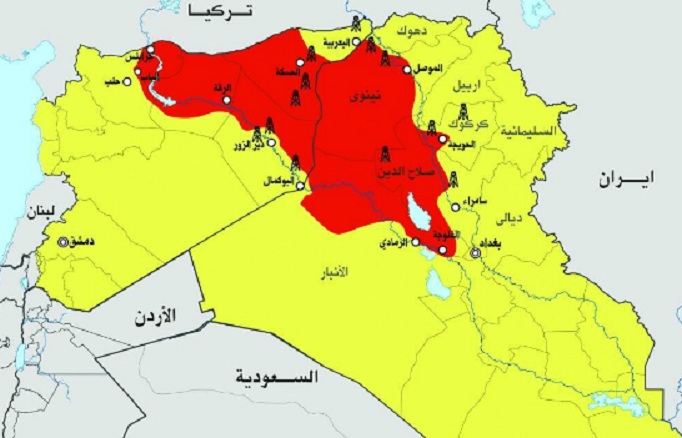
ISIS hopes to use this caliphal statelet as the launching pad
for a much bigger, idealized transcontinental Islamic polity: 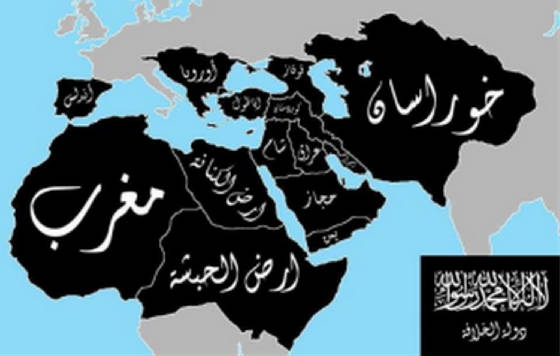
(Thanks to syriadeeply.)
Such a caliphal dream is of course a fantasy, but
it is a dangerous one nonetheless, which already inspires ISIS to acts of savagery in the region, and will eventually motivate
the followers of Abu Bakr al-Baghdadi to go after not just fellow Muslim rawafid (“rejecters”) but Jews and “Crusaders” outside the Middle East—eventually in New York and other American targets.
2:18 pm edt
Tuesday, June 3, 2014
Neither Promised Land Nor Crusader State: Obama at West Point
Yesterday my analysis of President Obama's West Point address on foreign policy was published on the History News Network. My two focal points are: 1)Obama's attempt to spell
out an approach to global engagement which rejects most historical American modes of doing so; and 2) his continued denial
that Islamic doctrines have anything to do with the legions of terrorists adducing Islam as their motivation and Islamic rule
as their goal.

The preferred stance of the American military vis-a-vis Islam, according to Barack Husayn
Obama.
|
|
|
|
| Jamkaran Mosque near Qom, Iran (during my trip there Aug. 2008) |
|
|
|
